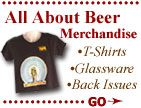
| ||||
| AAB Departments |
| ...Beer Features |
| ...Beer Talk |
| ...Pull Up A Stool! |
| ...What's Brewing |
| ...Beer Travelers |
| ...Stylistically Speaking |
| ...Beer & Food |
| ...Homebrewing |
| ...Collectibles |
| ...Marketplace |
| Beer Lovers' Resources |
| ...World Beer Festival |
| ...Brew Cruise Info |
| ...AAB Merchandise |
| ...AAB Bookstore |
| ...Beer Links |
| About the Magazine |
| ...Subscription Info |
| ...Retail the Magazine |
| ...Advertising Info |
| ...Contact AAB |

|
Collectables
Beer Reruns
Madison Avenue does its best to have us believe that the brewing industry continues to roll out new products. The fact of the matter is that breweries are better recyclers than they are inventors. The "new" categories created by today’s beer marketers are largely reruns of past product introductions. As the cable TV industry tries to fill 500 channels by repackaging shows from days gone by, it seems as if they took advice from the brewing industry.
In the last decade, we have seen dry beer return, along with the reinvention of flavored malt liquors and light and genuine draft beers. These products all were introduced as if they were the newest and most inventive brewed product to date, but for "beer archaeologists," the calendar seemed to be on rewind.
The first low calorie or "light" beer was Gablinger’s in 1967. The Rheingold Brewery of New York City brewed it; Dr. Joseph Owades developed it. The brewery owners were afraid that their reputation might be damaged if the beer was a failure. As a precaution, they chose the name Forrest Brewing Co., after Forrest Street, on which Rheingold brewery was located, to label this beer.
Long before the "light" beer craze swept the country, many breweries were producing light beers, beers that emphasized their pale color and not their calorie content. Most brewers moved their customers to a paler brew because grain rationing during World War II forced the breweries to find alternatives to malted barley. These cereal grains became commonplace but yielded a lighter beer.
One of the first to buck this trend was Rainier Brewing of Seattle, with a heartier lager named "not-so-light." Other brewers boasted of "pre-War strength." The hop ratio also changed as the cereal grain usage increased, making for a much drier brew. Most brewers promoted the "dry beer" aspect to distract the consumer from the changing flavors caused by the use of different grains.
The advent of sterile filtration after WWII allowed for the release of unpasteurized or "draft" beer. The tight filtration removed elements that could shorten the shelf life of this style, but due to the lack of heat pasteurization, most of these beers required constant refrigeration. This necessity was usually emphasized by the use of a wood grain or keg motif on the brand’s label. In the 1980s, filtration improvements made way for the re-release of unpasteurized beers like MGD.
Malt liquor debuted just after WWII when the grain rations were lifted. The Grand Valley Brewing Co. of Ionia, MI, created this style, followed shortly thereafter by the Gluek Brewery of Minneapolis.
Malt liquor took a different path in the late 1960s when flavorings were added. Varieties like apple, grape, tropical, burgundy and champagne appeared on the scene. The baby boomers reaching college age at this same time helped to increase sales of this flavored style, which contained a higher amount of alcohol. These unique products were the forerunners of Zima, Hooper’s Hooch, and Smirnoff Ice.
Beer Dave Gausepohl has collected breweriana since 1974 and has a personal collection of over 400,000 items. He has visited over 1,000 breweries and tasted well over 10,000 different brews from the world over.









